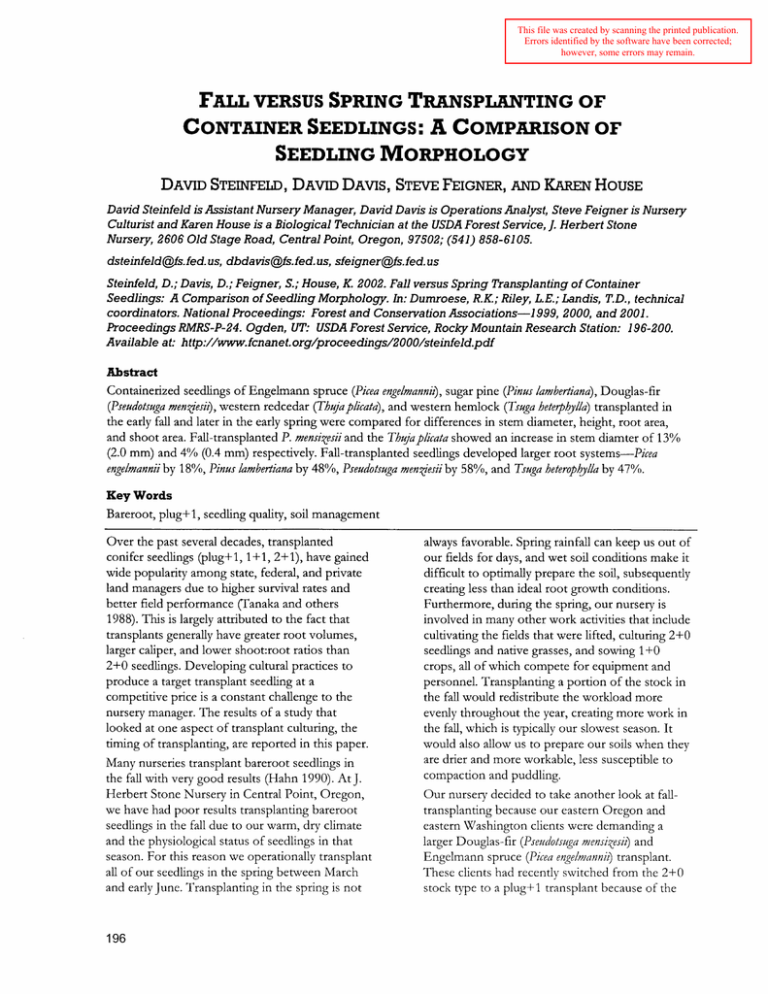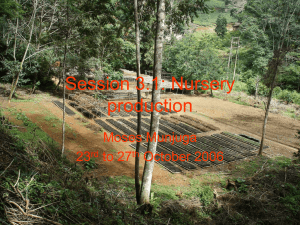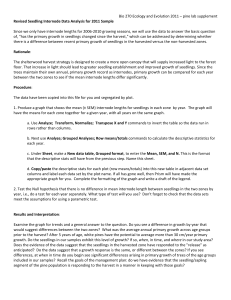TRANSPLANTING FALL SPRING OF
advertisement

This file was created by scanning the printed publication. Errors identified by the software have been corrected; however, some errors may remain. FALLVERSUS SPRINGTRANSPLANTING OF David Steinfeld isksistant Nursery Manager, David Davis is Operations Analyst, Steve Feigner is Nursery Culturist and Karen House is a Biological Technician at the USDA Forest Service, J. Herbert Stone Nursery, 2606 Old Stage Road, Central Point, Oregon, 97502; (541) 858- 61 05. dsteinfeldW s .fed.us, dbdavisws.fed.us, sfeignerws.fed.us Steinfeld, D.; Davis, D.; Feigner, S.; House, K. 2002. Fall versus Spring Transplanting o f Container Seedlings: A Comparison of Seedling Morphology. In: Dumroese, R.K.; Riley, L.E.; Landis, T.D., technical coordinators. National Proceedings: Forest and Conservation Associa tions-1999, 2000, and 2001. Proceedings RMRS-P-24. Ogden, UT: USDAForest Service, Rocky Mountain Research Station: 196-200. Available at: http://www.fcnanet.org/proceedings/2000/steinfeld.pdf Abstract Containerized seedlings of Engelmann spruce (Picea engelmanniz), sugar pine (Pinzls lambertiana), Douglas-fir (Pezddat~ugamen@e.riz),western redcedar (Tbzyaplicata), and western hemlock (T~ugahetepbylla) transplanted in the early fall and later in the early spring were compared for differences in stem diameter, height, root area, and shoot area. Fall-transplanted P. mensi~eiiand the Thzyaphata showed an increase in stem diamter of 13% (2.0 mm) and 4% (0.4 mm) respectively. Fall-transplanted seedlings developed larger root systems-Picea engehannii by 18%, Pinw lambertiana by 48Y0, P~eudotszlgamenee~iiby 58%, and Tsuga heteroplylla by 47%. Key Words Bareroot, plug+ 1, seedling quality, soil management Over the past several decades, transplanted conifer seedlings @lug+l , 1 + 1,2+ I), have gained wide popularity among state, federal, and private land managers due to higher survival rates and better field performance (Tanaka and others 1988). This is largely attributed to the fact that transplants generally have greater root volumes, larger caliper, and lower shoot:root ratios than 2+0 seedlings. Developing cultural practices to produce a target transplant seedling at a competitive price is a constant challenge to the nursery manager. The results of a study that looked at one aspect of transplant culturing, the timing of transplanting, are reported in this paper. Many nurseries transplant bareroot seedlings in the fall with very good results (Hahn 1990). At J. Herbert Stone Nursery in Central Point, Oregon, we have had poor results transplanting bareroot seedlings in the fall due to our warm, dry climate and the physiological status of seedlings in that season. For this reason we operationally transplant all of our seedlings in the spring between March and early June. Transplanting in the spring is not always favorable. Spring rainfall can keep us out of our fields for days, and wet soil conditions make it difficult to optimally prepare the soil, subsequently creating less than ideal root growth conditions. Furthermore, during the spring, our nursery is involved in many other work activities that include cultivating the fields that were lifted, culturing 2+0 seedlings and native grasses, and sowing 1+0 crops, all of which compete for equipment and personnel. Transplanting a portion of the stock in the fall would redistribute the workload more evenly throughout the year, creating more work in the fall, which is typically our slowest season. It would also allow us to prepare our soils when they are drier and more workable, less susceptible to compaction and puddling. Our nursery decided to take another look at falltransplanting because our eastern Oregon and eastern Washington clients were demanding a larger Douglas-fir (Pseudotsz~gamensixesiz) and Engelmann spruce (Picea engelmanniz) transplant. These clients had recently switched from the 2+0 stock type to a plug+l transplant because of the difficulty of obtaining a large 2+0 seedling on a consistent basis. While our clients were pleased with 1+1 transplants, our nursery wanted to continue to increase overall seedling size by transplanting in the fall instead of the spring. We also wanted to evaluate the feasibility of transplanting western hemlock (Tsuga beterq&la), western redcedar (Tbqaplicata), and sugar pine (Pintrs lambertiana) in the fall to see if we could produce more balanced seedlings for these species. The study was set up in a paired plot design with treatments replicated four times. All seed sources came from national forests in Oregon-western redcedar and western hemlock were from the Siulsaw, sugar pine from the Fremont, Engelmann spruce from the Umatilla, and Douglas-fir from the Wallowa-Whitman national forests. Seedlings were started in Styro 4A@containers that were sown at J. Herbert Stone Nursery in April 1998. They were grown under greenhouse conditions until late summer when they were moved outside to harden off. O n September 30,1998, seedlings for the fall-transplant treatment were extracted from the containers and immediately transplanted in fumigated fields. Seedlings were planted in 1.2 m (4 ft) beds in 7 rows at a density of 64 seedlings per square meter (6 seedlings/ft2). N o special culturing treatments were made on these seedlings from the time they were transplanted to the time spring-transplant treatment seedlings were planted. Seedlings for the spring-transplant treatment were maintained outside until they were extracted and processed on January 4, 1999. They were kept in freezer storage at -1 OC (30 OF) for three months, then thawed and transplanted on April 7, 1999, in beds adjacent to the falltransplant treatment. From that point forward, seedlings of both treatments were grown under the same standard nursery growing regmes for Douglas-fir transplants. Seedlings were lifted on February 16,2000. Seedling morphology was measured on the falltransplanted seedlings on September 30, 1978; on the spring-transplanted treatment on January 4, 1799, prior to freezing; on the fall-transplanted seedlings on March 2,1977; and on both treatments on February 16,2000. Stem diameter, top height, projected shoot area, and projected root area measurements were made on each seedling using Machine Vision Seedling Inspection Station@equipment. This is a high-resolution linescan camera implemented on PC-compatible computer hardware, programmed to measure seedling morphological characteristics (Rgney and Kranzler 1994; Davis and Scholtes 1775). Machine Vision measures stem diameter at the cotyledon scar, shoot length from the cotyledon scar to the tip of the seedling bud and root and shoot areas as a two dmensional projection of roots and shoots, measured as cm2. Root area has been shown to positively correlate with root volume in work reported by Davis and Scholtes (1995). RESULTS There were significant differences in stem diameter for Douglas-fir and western redcedar between treatments. The seedlings from the falltransplanted treatment had a stem diameter 13% (1.0 mm) and 4% (0.4 mm) greater than what had been measured in September, respectively (Table 1). Only the Engelmann spruce showed a significant difference in shoot length, with the spring-transplanted seedlings being larger by 15% (4.5 cm). Spring-transplanted Engelrnann spruce seedlings also had greater shoot area while falltransplanted seedlings of sugar pine and Douglasfir displayed an increase in shoot area of 110% and 24%, respectively. Transplanting seedlings in the fall produced larger root systems. All species, except western redcedar, showed a significant difference (90% confidence interval) between treatments for root area (Figure 1). Engelmann spruce increased by 18%, sugar pine by 48%, Douglas-fir by 58%, and western hemlock by 47%. There were no differences in survival for either the spring or fall transplants. ' 0mortality. Both treatments sustained less than 5 1 The results of this trial support our decision to transplant containerized seedlings in the fall. One of our concerns had been whether the falltransplanted seedlings could weather a cold winter. The winter of 1799 was a good year to test this because temperatures dropped to -15 O C (5 '8for 4 days in January 1999. Seedlings did not frost heave or show any frost damage on the needles in the spring in response to this event. We attribute this to the fact that the root growth on fall-transplanted seedlings had extended beyond Table 1. Picea emgelmannii Pinus lambertiana Pseudotsuga menziesii Thuja plicata Tsuga heterophylla Caliper (mm) Fall-transplanted Spring-transplanted 9.8 9.2 5.9 5.4 8.8** 7.8 9.2** 8.9 8.3 8.0 Shoot Length (cm) Fall-transplanted Spring-transplanted 25.9** 30.4 21.3 18.7 29.0 28.2 54.9 55.9 42.8 44.6 Root Area (cm2) Fall-transplanted Spring-transplanted 1go** 162 92** 62 151** 96 150 120 259* 177 Shoot Area (cm2) Fall-transplanted Spring-transplanted 89** 104 78* 37 100* 81 423 399 27 1 27 1 Within each morphological characteristic, the ** and * indicate significant differences at the 0.05 and 0.01 levels, respectively. 20 to 25 cm (8 to 10 in) in the soil by December, allowing seedlings to become anchored and have access to soil moisture below the frozen soil depth level of 13 cm (5 in). The root growth period immediately after transplanting is very important for seedling establishment and growth. In the fall of 1998, after the fall-transplanted seedlings were planted, average air temperatures for October and November were 11 OC (51.5 O F ) and 8 OC (45.7 OF) respectively. The warm temperatures, typical of our area, along with clear, mild days are favorable for root growth. Figure 2 is a conceptual drawing based on seedling measurements made at extraction of both treatments, in the late winter 1999 and at lift and pack, showing the difference between the growth of fall-transplanted and spring-transplanted seedlings after transplanting. We were surprised to see that the fall-transplanted seedlings did not develop more root area in the fall than the seedlings held in containers for the spring-transplanted treatments. Both treatments came into the spring with similar root areas. The difference was the fall-transplanted seedlings developed new roots that extended into the soil while the spring-transplanted seedlings continued to grow roots within the confines of the containers. As the seedlings of the falltransplanted treatment began to grow in the spring, their root systems were already well established, which reduced the amount of "transplant shock" that is often observed in transplants. Tne seedlings of the springtransplanted treatments, on the other hand, transplanted in April, missed the potential for root growth during the month of March. While the spring-transplanted seedlings were coming out of dormancy from cold storage, the fall-transplanted seedlings had already captured up to 6 weeks of root growth. In addition to developing a seedling with better morphological characteristics, transplanting seedlings in the spring gives our nursery more flexibility in how we manage our work force, equipment, and soils. During the spring we hire two transplanting crews but often do not complete transplanting until early June. Moving a portion of this work to the fall can significantly reduce our spring workload while increasing workloads in the fall, which is typically our slowest time of year. It also will help in soil preparation because the soils in the fall are much drier and more workable than in the spring. On soils with moderate to poor drainage, soil preparation and transplanting in the spring, when the soils are wet, create soils that are compacted, puddle and lack internal drainage. Root growth and morphology can be severely affected by these soil conditions. Figure I Picea engelmannii Pinus lambertiana Pseudotsuga menziesii Thuja plicata Tsuga heterophylla The ** and * represent significant difference from the spring treatments of 0.05 and 0.1 level, respectively Figure 2: Oct 98 Jan 99 Apr 99 Feb 00 Our nursery expects to reduce the costs of our plug+l seedlings by transplanting in the fall and eliminating the costs of extraction, storage, and handling that would be incurred if the seedlings were not transplanted until the following spring. Typically, spring-transplanted seedlings are extracted, placed in storage containers, frozen, brought out of storage and thawed, removed from their storage containers, and transplanted. With fall-transplanted seedlings, we simply extract seedlings in the greenhouses into tubs that go immediately to the transplanters. This eliminates storage containers, storage facilities, and the extra handling associated with this operation. From a seedling-quality standpoint, seedlings are handled once and held for only a short time between extraction and transplanting, which should reduce transplant shock. The results of this study support our decision to transplant containerized seedlings in the fall. In early October 1999 we successfully transplanted 500,000 seedlings. Our plan for 2000 is to move the transplant date up to early September to capture the warm late-summer soil temperatures for greater root growth. Transplanting in the fall at our nursery will produce a more balanced, larger seedling at reduced costs, whde allowing the nursery more flexibility in managing our work force and equipment. LITERATURE CITED Davis, D.B., and Scholtes, J.R. 1995. Machine vision development and use in seedling quahty monitoring inspection. IN: Landis, T.D.; Cregg, B., tech. coords. National proceedings, forest and conservation nursery associations. Gen. Tech. Rep. PNW-365. Portland, OR: U.S. Department of Agriculture, Forest Service, Pacific Northwest Research Station: 75-79. Hahn, P.F. 1990. The use of Styroblock 1 & 2 containers for P+ 1 transplant stock production. Rose, R.; Campbell, S. J.; Landis, T. D., eds. Target seedling symposium proceedings, combined meeting of the western forest nursery associations. Gen. Tech. Rep. RM-200. Fort Collins, CO: U.S. Department of Agnculture, Forest Service, Rocky Mountain Forest and Range Experiment Station: 218-222. Rqpey, M. P. and Kranzler G.A. 1994. Machine vision inspection system for packing house quality control. Landis, T.D.; Dumroese, R.K., tech. coords. National proceedings, forest and conservation nursery associations. Gen. Tech. Rep. RM-257. Fort Collins, CO: US. Department of Agnculture, Forest Service, Rocky Mountain Forest and Range Experiment Station: 182-191. Tanaka, Y.; Carrier, B.; Dobkowski, A; Figueroa, P.; and Meade, R. 1988. Field performance of mini-plug transplants. Landis, T.D., tech. coord. Proceedings, combined meeting of the western forest nursery associations. Gen. Tech. Rep. RM-1677. Fort Collins, CO: U.S. Department of Agriculture, Forest Service, Rocky Mountain Forest and Range Experiment Station: 172-181.






